In June 2024, during his presidential campaign, President Donald Trump joined venture capitalist David Sacks and Jason Calacanis on the “All-In” podcast, where Calacanis told President Trump that liberalizing immigration policy would be critical to winning the AI race. Trump promptly agreed, mentioning that he will ensure all international students graduating from U.S. universities automatically get a green card with their diploma and that this will be a “day one” issue for him. That was then.
Now in his second term, Trump says he maintains his desire to cultivate American leadership in AI. He issued an executive order on his third day in office promising to remove “barriers to American leadership in artificial intelligence.” To achieve this goal, Trump tasked officials with submitting an AI Action Plan within 180 days of the order and repealed President Biden’s executive order on safe and trustworthy AI. Though both orders maintained the need to advance American leadership in AI, Trump’s had no mention of loosening immigration restrictions, standing in contrast to Biden’s order that listed attracting the “world’s AI talent to our shores” as a priority.
The AI talent pipeline
Tech giants have long called for loosening visa restrictions to attract foreign talent to the United States, in part because many are first-generation immigrants themselves. Elon Musk, founder of Tesla and SpaceX; Jensen Huang, founder of Nvidia; and Aravind Srinivas, co-founder of Perplexity AI, are all first-generation immigrants.
According to the National Foundation for American Policy (NFAP), 77% of the top AI companies in the United States were founded or co-founded by first- or second-generation immigrants. Immigrants have founded more than half of U.S. startup companies valued at $1 billion or more, many in AI or related tech fields. Out of the top 48 U.S.-based AI companies, Indian and Chinese Immigrants have founded nine and eight, respectively.
Most first-generation leaders also entered the U.S. as children or international students in higher education. Forty-two percent of the top U.S.-based AI companies were founded by someone who came to the U.S. as an international student. This is unsurprising given that international students make up 70% of full-time graduate students in AI-related fields.
The F-1 visa revocation frenzy
In early April, 1,800 international students on F-1 (student visa) and J-1 (exchange visitor visa) visas across 280 colleges and universities had their visas abruptly revoked with no warning or recourse, and many without explanation. Secretary of State Marco Rubio claimed that these visa revocations were targeting students involved in activities that “run counter” to national interests, but many of those affected had no criminal convictions or any political engagements. On April 25, the administration announced that it would restore all terminated student statuses, reversing previous visa revocations. Since then, President Trump has been in contentious spats with university presidents and eliminated research and development projects critical to solidifying U.S. leadership in innovation. These debates have led China to open its doors to both international and American students at their universities, which could potentially lead to a talent drain.
Though the students’ statuses have since been restored, the administration’s abrupt policy changes have created uncertainty and negative impacts for international students. Those who had their visas revoked now face added administrative burdens, including visiting an embassy to apply for a new visa and enduring long wait times—with no guarantee they will regain it despite the abrupt conditions of the revocations. For some, the reversal may have come too late: Fearing detention after discovering their legal status had been terminated, some students and early-career professionals left the U.S. and are now “stranded” in their home countries, unable to return to complete their programs. A more recent policy change also now requires all student visa applicants to disclose their social media accounts and set them to “public,” enabling the government to monitor their digital activity.
Given the number of international students pursuing degrees in AI-related fields, President Trump’s recent visa policy whiplash has disproportionately impacted those who may help the U.S. lead in AI. Of the 21 lawsuits filed against the government with known student majors, nine involve students in computer science, data science, or other tech-related fields. Most of these lawsuits involve doctoral students or recent graduates in optional practical training (OPT), which allows F-1 visa holders to work in the U.S. for one year upon completing their degrees. According to a recent report by NAFSA, the top two countries with the greatest number of affected students are India and China, each with more than 300 students impacted. For those from those countries, the policies have raised concerns about hostility toward international students and scholars, who remain vulnerable to sudden policy changes.
Failures of US immigration and talent retainment
The H-1B visa program, which allows highly skilled foreign nationals to work in the U.S. for a temporary period, has been the primary method for American-educated international students to remain in the U.S. after graduation. India and China are the top two origin countries of H-1B visa recipients, corresponding to the volume of international students studying in the U.S. from these countries. About 65% of the approved H-1B workers are employed in computer-related jobs, rendering this program critical for the tech industry. Big tech companies, such as Amazon, Google, and Microsoft, are some of the largest sponsors for H-1B visas, demonstrating the strong demand for foreign talent in leading U.S. tech firms. However, during President Trump’s first term, the denial rate for the visa peaked, reaching 15% in 2018. Though the denial rate fell to a historic low under Biden, concerns remain that the Trump administration could reinstate earlier policies, given its past immigration crackdowns and visa reversals affecting thousands of international students, though no specific actions have been taken yet.
Indian and Chinese nationals already face some of the narrowest pathways to legally remain in the United States, despite being among the highest achieving demographic groups in the country. Due to a cap on green cards for each country, India and China rank first and second for the longest wait times for employment-based permanent residency, with 400,000 Indian applicants unlikely to receive status within their lifetimes. Many entered the country through student visas, hoping to remain after graduation through employer-sponsored visas. Yet the odds of winning the visa lottery are about 1 in 4, with some estimates showing that they have plummeted to about 1 in 7 in recent years due to high demand. Because of unfavorable immigration policies, 60% of foreign Ph.D. recipients in the U.S. say they face difficulties staying in the country, compared to only 12% of Ph.D. holders in other countries.
As a result of systemic barriers in immigration, the U.S. will likely experience a dramatic decline in the quantity of talent. Staff cuts at immigration agencies, reductions in research funding, and the revocation of Harvard’s ability to enroll international students may further worsen an already unfavorable talent migration landscape. Trump’s recent travel bans on 12 countries applies to both immigrants and non-immigrants, including those with student and exchange scholar visas. According to nonimmigrant data from the 2023 fiscal year, more than 280,000 students are expected to be impacted.
This stands in sharp contrast to the more welcoming immigration policies of the United Kingdom, Australia, and Canada, which actively recruit workers with in-demand skills and offer streamlined paths to naturalization. Canada attracted nearly 40,000 foreign-born graduates of U.S. universities from 2017 to 2021. The U.K., whose existing policies are already more flexible for foreign-born graduates, recently introduced “High Potential Individual” visas to recruit people with advanced degrees from top universities around the world—including 20 in the United States. As a partner at a London-based immigration law firm noted: “[The U.K is] a beneficiary of the failures of the U.S. system.”
Healthy talent immigration policies should not compete with American talent
In mid-July, the Washington Post allegedly leaked messages from tech entrepreneur and leading venture capitalist Marc Andreessen in which he appeared to support the Trump administration’s efforts to dismantle diversity, equity, and inclusion (DEI) policies at U.S. colleges and universities. In the reported messages, Andreessen claimed that DEI initiatives had resulted in reverse discrimination against qualified white students, costing them opportunities in emerging and established industries—a belief often tied to racial displacement theories. These views reflect broader sentiments behind recent shifts in immigration policy, including the restructuring of visas and work permits and a more aggressive approach to perceived national security threats. As the U.S. competes with China in AI and related sectors, it must reassess how it manages its talent pipeline and labor supply to remain globally competitive.
Going forward
Despite President Trump’s earlier promises to expand immigration access for international students, recent actions by his administration suggest otherwise. As other countries build faster, more streamlined paths to residency for global AI and tech talent, the U.S. risks falling behind. If the U.S. truly aims to lead the world in AI, it must first dismantle systemic barriers that drive away the very people fueling its innovation. That means establishing consistent, forward-looking immigration policies insulated from short-term political shifts and geopolitical tensions.
AI innovation is not powered by algorithms alone, but by people—many of whom come from abroad to study, build, and dream in the United States. The question, then, isn’t whether America can lead in AI, but whether it’s willing to do what’s necessary to retain the people who make that leadership possible.
-
Acknowledgements and disclosures
Amazon, Google, and Microsoft are general, unrestricted donors to the Brookings Institution. The findings, interpretations, and conclusions posted in this piece are solely those of the authors and are not influenced by any donation.
The Brookings Institution is committed to quality, independence, and impact.
We are supported by a diverse array of funders. In line with our values and policies, each Brookings publication represents the sole views of its author(s).
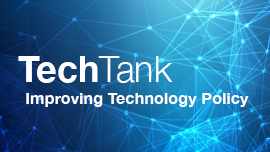
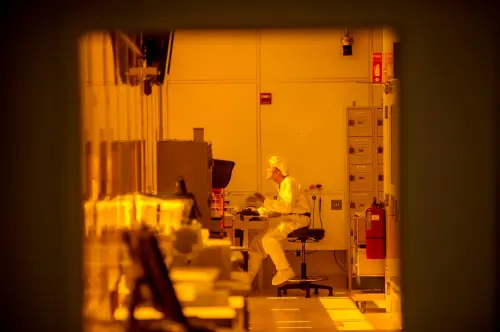
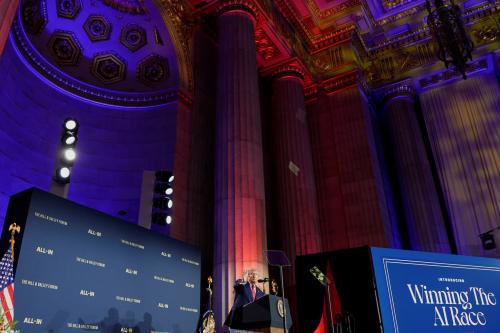
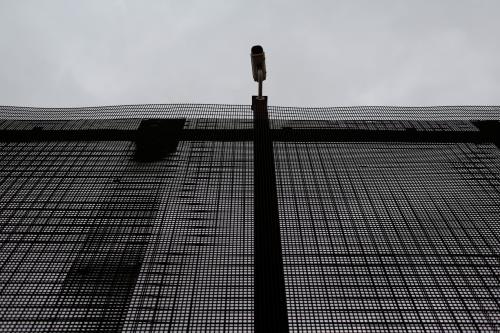
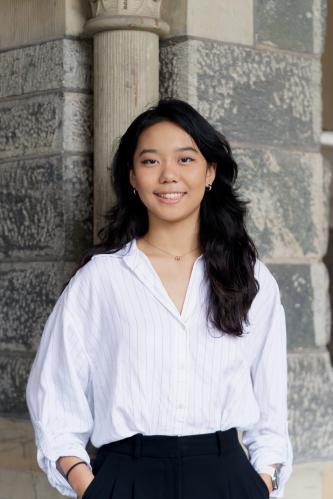

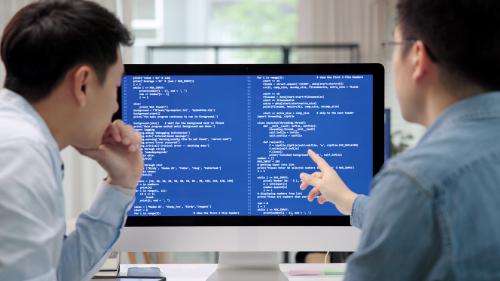
Commentary
Trump’s immigration policies may threaten American AI leadership
July 21, 2025